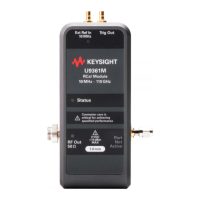22 U9361C/F/G/M RCal Measurement Guide
Getting Started
Connector Care
Connector Care
Making Connections
Good connections require a skilled operator. Instrument sensitivity and coaxial
connector mechanical tolerances are such that slight errors in operator
technique can have a significant effect on measurements and measurement
uncertainties.
The most common cause of measurement error is with poor connections.
Connection Procedure
1. Ground yourself and all devices (wear a grounded wrist strap and work on
an antistatic mat).
2. Visually inspect the connectors (refer to Visual Inspection).
3. If necessary, clean the connectors (refer to Cleaning Connectors).
4. Carefully align the connectors. The male connector center pin must slip
concentrically into the contact fingers of the female connector.
5. Push the connectors straight together. Do not twist or screw them
together. As the center conductors mate, there is usually a slight
resistance.
6. Initial tightening can be done by hand or with an open-end wrench.
Tighten until "snug" or where the connectors are first making contact. The
preliminary connection is tight enough when the mating plane surfaces
make uniform, light contact. Do not over tighten this connection. At this
point, all you want is for the outer conductors to make gentle contact on
both mating surfaces. Use very light finger pressure (no more than 2
inch-pounds of torque).
7. Relieve any side pressure on the connection from long or heavy devices or
cables. This assures consistent torque.
8. Torque the cable or device to the final value using a torque wrench.
Cleaning Connectors
1. Inspect the connectors for dust, dirt, metal fragment, oils or film, and
debris.
2. Blow off any dust with a filtered, clean supply of compressed air.
Do not twist one connector into the other (like inserting a light bulb). This
happens when you turn the device body, rather than the connector nut.
Major damage to the center conductor and the outer conductor can occur
if the device body is twisted.

